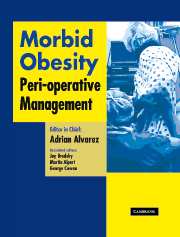Book contents
- Frontmatter
- Contents
- Contributors
- Foreword
- Preface
- Acknowledgments
- Dedication
- Section 1 General aspects
- Section 2 Pathophysiology
- Section 3 Pre-operative management
- Section 4 Peri-operative management of co-morbidities
- 10 Diabetes mellitus
- 11 Co-existing cardiac disease
- 12 Deep venous thrombosis prophylaxis
- 13 Surgical antibiotic prophylaxis
- 14 Renal dysfunction
- Section 5 Pharmacology
- Section 6 Monitoring
- Section 7 Intra-operative management
- Section 8 Post-operative care
- Section 9 Conclusions
- Afterword
- Index
13 - Surgical antibiotic prophylaxis
from Section 4 - Peri-operative management of co-morbidities
Published online by Cambridge University Press: 17 August 2009
- Frontmatter
- Contents
- Contributors
- Foreword
- Preface
- Acknowledgments
- Dedication
- Section 1 General aspects
- Section 2 Pathophysiology
- Section 3 Pre-operative management
- Section 4 Peri-operative management of co-morbidities
- 10 Diabetes mellitus
- 11 Co-existing cardiac disease
- 12 Deep venous thrombosis prophylaxis
- 13 Surgical antibiotic prophylaxis
- 14 Renal dysfunction
- Section 5 Pharmacology
- Section 6 Monitoring
- Section 7 Intra-operative management
- Section 8 Post-operative care
- Section 9 Conclusions
- Afterword
- Index
Summary
Introduction
In developed countries, almost 25% of nosocomial infections are related to wound surgical infections. As a consequence of this, medical costs are increased in 20–30% while hospitalization time is almost duplicated. On the other hand, this type of infections may cause permanent disability.
The term “prophylaxis” refers to the precautions and actions to be taken in order to prevent diseases.
Every year, a large number of patients are undergoing surgical procedures and, surgical antibiotic prophylaxis (SAP) is used to prevent post-operative infections.
Post-operative infections have always limited the development of new surgical techniques.
Antibiotics must be used before many surgical procedures besides other infection control measures, the administration of appropriate antiseptics and the understanding of the physiopathology of infections. Although the principles of pre-operative administration of antibiotics in surgery have been clearly established, this subject is still controversial.
Infections are a constant risk in surgical procedures. Bacteria are found in 90% of surgical incisions, notwithstanding the technique used or the surgical site (even in laminar flow environments). Initially, bacterial count is low, but its development is stimulated by favorable local conditions (hematoma, ischemia, modifications in the oxidation—reduction potential) and the weakening of the host's immune defenses as well. In case of patients undergoing surgery, the objective of antimicrobial prophylaxis therapy is the reduction of surgical site infections (SSI) through the prevention of microbial proliferation.
- Type
- Chapter
- Information
- Morbid ObesityPeri-Operative Management, pp. 173 - 194Publisher: Cambridge University PressPrint publication year: 2004
- 1
- Cited by

